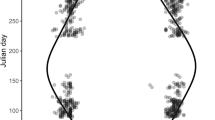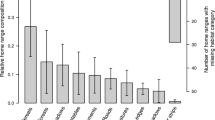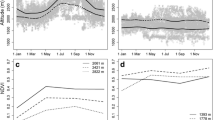Abstract
During the last half-century, the distribution of golden jackals (Canis aureus) has rapidly increased throughout Europe. Today, golden jackals are thriving in human-dominated landscapes across Southeastern and Central Europe. Most studies on golden jackals have focused on large-scale distribution patterns; to date, little is known about the species’ fine-scale spatial ecology. In this study, we analyzed the movement behavior, space-use and resource selection of six golden jackals fitted with GPS-GSM collars in two study areas in Hungary and Serbia. Two of the jackals were a breeding pair. We found that home range size averaged 11.2 km2 (90% autocorrelated kernel density estimation), and was characterized by significant individual-level variability (range 1.3–32.5 km2). Golden jackal movements and resource selection were strongly influenced by circadian patterns: during the day, jackals travelled an average of 300 m every 6 h, and all monitored individuals selected for vegetation cover, often near edges. At night, golden jackals travelled significantly further (1 km 6 h−1), and were more likely to venture outside of cover into agricultural areas. Movement analysis of the breeding pair revealed that the male and female tended to remain in close proximity during the day, but ranged more independently at night. Altogether, our findings suggest that golden jackals’ ability to thrive in human-dominated landscapes rely on a fine spatio-temporal avoidance of humans.




Similar content being viewed by others
Code availability
The analyses relied on established statistical procedures described in the reference literature.
References
Admasu E, Thirgood SJ, Bekele A, Karen Laurenson M (2004) Spatial ecology of golden jackal in farmland in the Ethiopian Highlands. Afr J Ecol 42:144–152. https://doi.org/10.1111/j.1365-2028.2004.00497.x
Aiyadurai A, Jhala Y (2006) Foraging and Habitat Use by Golden Jackals (Canis aureus) in the Bhal region, Gujarat, India. J Bombay Nat Hist Soc 103:5–12
Alexandre M, Hipólito D, Ferreira E et al (2020) Humans do matter: determinants of red fox (Vulpes vulpes) presence in a western Mediterranean landscape. Mammal Res 65:203–214. https://doi.org/10.1007/s13364-019-00449-y
Andru J, Ranc N, Guinot-Ghestem M (2018) Le chacal doré fait son chemin vers la France. Faune Sauvage 320:21–27
Arnold J, Humer A, Heltai M et al (2012) Current status and distribution of golden jackals Canis aureus in Europe. Mamm Rev 42:1–11. https://doi.org/10.1111/j.1365-2907.2011.00185.x
Burnham K, Anderson D (2002) Model selection and multimodel inference: a practical information-theoretic approach. Springer, New York
Calenge C (2006) The package adehabitat for the R software: tool for the analysis of space and habitat use by animals. Ecol Modell 197:1035
Carricondo-Sanchez D, Odden M, Kulkarni A, Vanak AT (2019) Scale-dependent strategies for coexistence of mesocarnivores in human-dominated landscapes. Biotropica 51:781–791. https://doi.org/10.1111/btp.12705
Červinka J, Šálek M, Pavluvčík P, Kreisinger J (2011) The fine-scale utilization of forest edges by mammalian mesopredators related to patch size and conservation issues in Central European farmland. Biodivers Conserv 20:3459–3475. https://doi.org/10.1007/s10531-011-0135-8
Charaspet K, Sukmasuang R, Khoewsree N, et al (2019) Movement, home range size and activity pattern of the golden jackal (Canis aureus, Linneaus, 1758) in Huai Kha Khaeng Wildlife Sanctuary, Thailand. Biodiversitas 20:3430–3438. https://doi.org/10.13057/biodiv/d201141
Ćirović D, Penezić A, Krofel M (2016) Jackals as cleaners: ecosystem services provided by a mesocarnivore in human-dominated landscapes. Biol Conserv 199:51–55. https://doi.org/10.1016/j.biocon.2016.04.027
Ćirović D, Plećaš M, Penezić A (2018) Home range and movement of golden jackal pair in human dominated landscape. In: Giannatos G, Banea OC, Hatlauf J et al (eds) 2nd International Jackal Symposium. Hellenic Zoological Archives, Marathon Bay, Attiki, Greece, p 87
Damiani ML, Issa H, Fotino G, et al (2015) MigrO: a plug-in for the analysis of individual mobility behavior based on the stay region model. In: GIS: Proceedings of the ACM International Symposium on Advances in Geographic Information Systems. Association for Computing Machinery, New York, 1–4
Damiani ML, Issa H, Fotino G et al (2016) Introducing ‘presence’ and ‘stationarity index’ to study partial migration patterns: an application of a spatio-temporal clustering technique. Int J Geogr Inf Sci 30:907–928. https://doi.org/10.1080/13658816.2015.1070267
Eijkelkamp MMA (2020) The arrival of the golden jackal (Canis aureus) in the Netherlands, Consequences for humans and nature. Rigksuniversiteit Groningen
European Environmental Agency (2015) Tree Cover Density. In: Copernicus L. Monit. Serv. https://land.copernicus.eu/pan-european/high-resolution-layers/forests/tree-cover-density. Accessed 22 Mar 2020
European Environmental Agency (2017) European Settlement Map. In: Copernicus L. Monit. Serv. https://land.copernicus.eu/pan-european/GHSL/european-settlement-map. Accessed 22 Mar 2020
Fleming CH, Fagan WF, Mueller T et al (2015b) Rigorous home range estimation with movement data: a new autocorrelated kernel density estimator. Ecology 96:1182–1188. https://doi.org/10.1890/14-2010.1
Fleming CH, Calabrese JM, Dong X, et al (2015a) ctmm: Continuous-time movement modeling. R Packag. version 0.2 8
Fortin D, Beyer HL, Boyce MS et al (2005) Wolves influence elk movements: behavior shapes a trophic cascade in Yellowstone National Park. Ecology 86:1320–1330. https://doi.org/10.1890/04-0953
Giannatos G (2004) Conservation Action Plan for the golden jackal Canis aureus L. in Greece
Giannatos G, Marinos Y, Maragou P, Catsadorakis G (2005) The status of the Golden Jackal (Canis aureus L.) in Greece. Belgian J Zool 135:145–149
Grinder MI, Krausman PR (2001) Home range, habitat use, and nocturnal activity of coyotes in an Urban Environment. J Wildl Manage 65:887. https://doi.org/10.2307/3803038
Hijmans R (2020) Raster: geographic analysis and modeling with raster data. R package version 3.4-5
Hody AW, Moreno R, Meyer NFV et al (2019) Canid collision—expanding populations of coyotes (Canis latrans) and crab-eating foxes (Cerdocyon thous) meet up in Panama. J Mammal 100:1819–1830. https://doi.org/10.1093/jmammal/gyz158
Hradsky BA, Robley A, Alexander R et al (2017) Human-modified habitats facilitate forest-dwelling populations of an invasive predator, Vulpes vulpes. Sci Rep 7:1–12. https://doi.org/10.1038/s41598-017-12464-7
Jenks KE, Aikens EO, Songsasen N et al (2015) Comparative movement analysis for a sympatric dhole and golden jackal in a human-dominated landscape. Raffles Bull Zool 63:546–554
Jirku M, Dostál D, Robovský J, Šálek M (2018) Reproduction of the golden jackal (Canis aureus) outside current resident breeding populations in Europe: evidence from the Czech Republic. Mammalia 82:592–595. https://doi.org/10.1515/mammalia-2017-0141
Kowalczyk R, Wudarczyk M, Wójcik JM, Okarma H (2020) Northernmost record of reproduction of the expanding golden jackal population. Mamm Biol 100:107–111. https://doi.org/10.1007/s42991-020-00009-x
Krofel M (2007) Golden Jackals (Canis aureus L.) on the Pelješac Peninsula (southern Dalmatia, Croatia). Nat Croat 16:201–204
Krofel M, Giannatos G, Ćirović D et al (2017) Golden jackal expansion in Europe: a case of mesopredator release triggered by continent-wide wolf persecution? Hystrix 28:9–15. https://doi.org/10.4404/hystrix-28.1-11819
Lanszki J, Heltai M, Szabó L (2006) Feeding habits and trophic niche overlap between sympatric golden jackal (Canis aureus) and red fox (Vulpes vulpes) in the Pannonian ecoregion (Hungary). Can J Zool 84:1647–1656. https://doi.org/10.1139/Z06-147
Lanszki J, Schally G, Heltai M, Ranc N (2018a) Golden jackal expansion in Europe: first telemetry evidence of a natal dispersal. Mamm Biol 88:81–84. https://doi.org/10.1016/j.mambio.2017.11.011
Lanszki J, Hayward MW, Nagyapáti N (2018b) Feeding responses of the golden jackal after reduction of anthropogenic food subsidies. PLoS ONE 13:e0208727. https://doi.org/10.1371/journal.pone.0208727
Lucherini M, Lovari S, Crema G (1995) Habitat use and ranging behaviour of the red fox (Vulpes vulpes) in a Mediterranean rural area: is shelter availability a key factor? J Zool 237:577–591. https://doi.org/10.1111/j.1469-7998.1995.tb05016.x
Männil P, Mustasaar M (2018) Jackal’s expansion towards north: Can they survive in boreal ecosystem? In: Giannatos G, Banea OC, Hatlauf J et al (eds) 2nd International Jackal Symposium. Hellenic Zoological Archives, Marathon Bay, Attiki, pp 110–111
Mitchell N, Strohbach M, Pratt R, et al (2015) Space use by resident and transient coyotes in an urban–rural landscape mosaic. Wildl Res
Moehlman PD (1987) Social Organization in Jackals: the complex social system of jackals allows the successful rearing of very dependent young. Am Sci 75:366–375
Mohr CO (1947) Table of equivalent populations of North American small mammals. Am Midl Nat 37:223. https://doi.org/10.2307/2421652
Newsome SD, Garbe HM, Wilson EC, Gehrt SD (2015) Individual variation in anthropogenic resource use in an urban carnivore. Oecologia 178:115–128. https://doi.org/10.1007/s00442-014-3205-2
Pasiok R (2019) Serval. QGIS plugin version 3.10.1
Penezić A, Ćirović D (2015) Seasonal variation in diet of the golden jackal (Canis aureus) in Serbia. Mammal Res 60:309–317. https://doi.org/10.1007/s13364-015-0241-1
QGIS Development Team (2016) Quantum GIS Geographic Information System
R Core Team (2016) R: A Language and Environment for Statistical Computing
Ranc N, Krofel M, Ćirović D (2018) Canis aureus - European regional assessment. In: The IUCN Red List of Threatened Species 2018
Ranc N, Moorcroft PR, Hansen KW et al (2020) Preference and familiarity mediate spatial responses of a large herbivore to experimental manipulation of resource availability. Sci Rep 10:11946. https://doi.org/10.1038/s41598-020-68046-7
Rotem G, Berger H, King R et al (2011) The effect of anthropogenic resources on the space-use patterns of golden jackals. J Wildl Manag 75:132–136. https://doi.org/10.1002/jwmg.9
Rutkowski R, Krofel M, Giannatos G et al (2015) A European concern? genetic structure and expansion of golden jackals (Canis aureus) in Europe and the Caucasus. PLoS ONE 10:e0141236. https://doi.org/10.1371/journal.pone.0141236
Šálek M, Drahníková L, Tkadlec E (2014a) Changes in home range sizes and population densities of carnivore species along the natural to urban habitat gradient. Mamm Rev. https://doi.org/10.1111/mam.12027
Šálek M, Červinka J, Banea OC et al (2014b) Population densities and habitat use of the golden jackal (Canis aureus) in farmlands across the Balkan Peninsula. Eur J Wildl Res 60:193–200. https://doi.org/10.1007/s10344-013-0765-0
Santana E, Armstrong J (2017) Food habits and anthropogenic supple-mentation in coyote diets along an urban-rural gradient
Seaman DE, Millspaugh JJ, Kernohan BJ et al (1999) Effects of sample size on kernel home range estimates. J Wildl Manag 63:739–747. https://doi.org/10.2307/3802664
Spassov N, Acosta-Pankov I (2019) Dispersal history of the golden jackal (Canis aureus moreoticus Geoffroy, 1835) in Europe and possible causes of its recent population explosion. Biodivers Data J 7:34825. https://doi.org/10.3897/BDJ.7.e34825
Therneau T (2020) A Package for Survival Analysis in R
Thurfjell H, Ciuti S, Boyce MS (2014) Applications of step-selection functions in ecology and conservation. Mov Ecol 2:4. https://doi.org/10.1186/2051-3933-2-4
Tolhurst BA, Baker RJ, Cagnacci F, Scott DM (2020) Spatial aspects of gardens drive ranging in urban foxes (Vulpes vulpes): the resource dispersion hypothesis revisited. Animals 10:1167. https://doi.org/10.3390/ani10071167
Trouwborst A, Krofel M, Linnell JDC (2015) Legal implications of range expansions in a terrestrial carnivore: the case of the golden jackal (Canis aureus) in Europe. Biodivers Conserv 24:2593–2610. https://doi.org/10.1007/s10531-015-0948-y
Way JG, Ortega IM, Strauss EG (2004) Movement and activity patterns of eastern coyotes in a coastal, suburban environment. Northeast Nat 11:237–254. https://doi.org/10.1656/1092-6194(2004)011[0237:MAAPOE]2.0.CO;2
Worton BJ (1989) Kernel methods for estimating the utilization distribution in home- range studies. Ecology 70:164–168. https://doi.org/10.2307/1938423
Acknowledgements
S. Fenton was supported by funds from the Museum of Comparative Zoology at Harvard University. N. Ranc was supported by a Harvard University Graduate Fellowship and a Fondazione Edmund Mach International Doctoral Programme Fellowship. Miklós Heltai was supported by the EFOP-3.6.3-VEKOP-16-2017-00008 project. József Lanszki was supported by the EFOP-3.6.2-16-2017-00014 project and fieldwork by the SEFAG Co. We thank the graduate students of the Harvard Statistical Consulting service, and especially Sanqian Zhang, for suggestions on the analyses, and Đura Nedeljković, Dejan Branković, Zoran Popov and Nikola Vojinović for their invaluable field assistance during the jackal trapping. Finally, we thank Editor-in-Chief Frank E. Zachos, Subject Editor Francesco Ferretti, and two anonymous reviewers for their constructive feedback on early versions of this manuscript.
Funding
This work was supported by the Museum of Comparative Zoology’s Grants-in-aid of Undergraduate Research at Harvard University, the grant from of Ministry of Education, Science and Technical Development of Republic of Serbia (TR 31009) and the SEFAG Co. (Hungary).
Author information
Authors and Affiliations
Contributions
NR, DC, JL and ML conceived the original idea; DC, JL, MH, SB, NB, IP and KA collected the data; SF and NR analyzed the data with support from PRM and FC; SF and NR led the writing of the manuscript with support from PRM. All authors contributed critically to the drafts, and gave final approval for publication.
Corresponding author
Ethics declarations
Conflict of interest
The authors declare no conflicts of interest/competing interests.
Ethics approval
The capture and tagging of wild golden jackals followed the official wildlife research procedures of Hungary and Serbia, respectively.
Consent for publication
All the authors give their consent for publication.
Availability of data and material
Golden jackals are heavily hunted in the study areas. Consequently, in the interest of wildlife conservation, we regret that the detailed locations will not be made publicly available.
Additional information
Handling editor: Francesco Ferretti.
Publisher's Note
Springer Nature remains neutral with regard to jurisdictional claims in published maps and institutional affiliations.
Supplementary Information
Below is the link to the electronic supplementary material.
Rights and permissions
About this article
Cite this article
Fenton, S., Moorcroft, P.R., Ćirović, D. et al. Movement, space-use and resource preferences of European golden jackals in human-dominated landscapes: insights from a telemetry study. Mamm Biol 101, 619–630 (2021). https://doi.org/10.1007/s42991-021-00109-2
Received:
Accepted:
Published:
Issue Date:
DOI: https://doi.org/10.1007/s42991-021-00109-2




